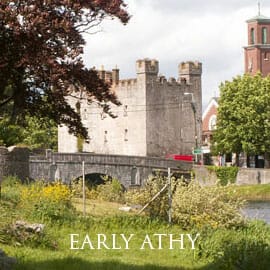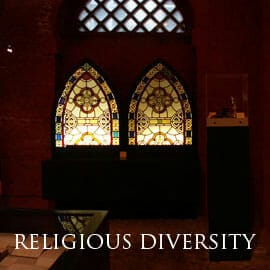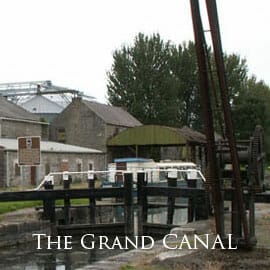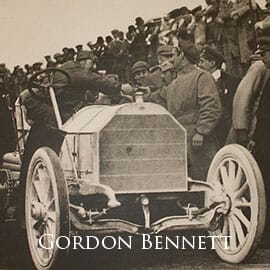Early Athy
The Ford of Ae
The name Athy dates back to the second century when Ae the son of Deargabhail, fosterer of Eochy Finn, was slain in a battle between the men of Munster and the men of Leinster. The battle was fought at a Ford on the river Barrow hence called Ath-Ae, the Ford of Ae, which was later anglicised into Athy.
Fords played an important role in ancient Ireland as roads were at best rough tracks and rivers which were important landmarks were crossed by fords. Ath-Ae was an important fording point on the river Barrow. This is confirmed by the quantity of archaeological objects retrieved from the bed of the river in the 1920s. These included Neolithic axeheads, Bronze Age swords and spearheads and a variety of Iron Age tools. There is no evidence, however, of a settlement at the ford until the latter end of the twelfth century.
Anglo-Norman Settlement
Athy initially developed as part of the Anglo-Norman settlement in Ireland. The Anglo-Norman adventurers led by Richard de Clare, better known as Strongbow, landed at Bannow, Co. Wexford in 1169.
Most of the province of Leinster came under Strongbow’s control. He granted lands in the area of Athy to Robert de St. Michael who was created Baron of Rheban. The St Michaels built Woodstock Castle in the early years of the thirteenth century near the ancient river crossing of Ath-Ae and a French speaking settlement sprung up around the castle. The construction of this fortress in a strategic location was a necessary defence against the native Irish who had been dispossessed of their lands by the Anglo-Norman settlers. Fortifications usually consisted of earthen banks topped with palisades but were later replaced by stone walls.
The Friars of the Holy Cross order founded a monastery on the west bank of the river Barrow near Woodstock Castle in the area now known as St. John’s. The Dominican order, which had come to Ireland in 1216 established a monastery on the east bank of the river in 1253 in the area known as the Abbey.
The Medieval Town
Poor living conditions in the early medieval town made it difficult to attract new villagers. Huts were crowded together and the villagers struggled under the triple terror of plague, early death and attack from the native Irish. Athy’s location on the Marches of Kildare made it particularly vulnerable to attack. As a fortification the town may have been walled by 1297. Evidence can be found in the Justiciar records where reference was made to Thomas the Janitor of Athy who would have been in charge of the town’s main gate.
To attract Anglo-Normans willing to settle in the area, narrow strips of land were offered along with Burgess status and civil liberties. The so-called Burgess plots ran perpendicular to the main street and consisted of a dwelling house facing onto the street with outhouses and a garden at the rear. In 1331, Athy had ten Burgesses who paid a total of 23 shillings and 1/2d to the lord of Athy manor. Corn grinding was carried out at the mill of the manor lord. Fees for corn grinding in the manors of Woodstock and Rheban were paid to the Fitzgeralds, the Earls of Kildare.
The Anglo-Norman settlers in the town of Athy came under frequent attack from the native Irish especially from the O’Moores of Laois. In 1300 provision was made for the building of a fortified castle, a fortalice, at Athy to strengthen the town’s defences. Yet during the fourteenth century Athy was attacked and burned four times by the O’Moores.
Towards the middle of the fourteenth century the Anglo-Norman settlers began a policy of retrenchment which focused attention on Athy as a settlement of strategic importance. Athy became a first line of defence against the hostile Irish leading to its development as a military stronghold. In 1417 Sir John Talbot, the Viceroy of Ireland, built a tower housing a garrison to protect the bridge over the river Barrow which is today known as Whites Castle.
In the late sixteenth century Athy was a vital supply line for the often beleaguered English settlers of Leix and Offaly and control of its bridges was essential for the continued supply of men, weapons and stores.
The House of Kildare
The Fitzgeralds were one of the most powerful houses in Ireland and ruled as the Earls of Kildare and Dukes of Leinster. They were landlords in Athy town and owned both Woodstock Castle and Whites Castle. Their strong connection with the town lives on in the street names of Athy: William Street, Duke Street, Leinster Street, Offaly Street, Stanhope Street and Emily Square all commemorate members of this family.
Lord Edward Fitzgerald, who died for his part in the 1798 Rebellion, represented Athy in the Irish Parliament. Several other members of the Fitzgeralds served as Sovereigns of Athy prior to the abolition of Athy Borough in 1840.
Henry VIII and the Monasteries
The conversion of King Henry VIII to the Protestant faith and his new role as head of church led to the suppression of all religious houses in Ireland between 1535 and 1540.
The Dominican Priory in Athy was confiscated on 19 August 1539 and a list of its property was compiled by a jury in Kilkea on 27 November. It consisted of a church, bell-tower, chapter house, dormitory, large hall, three chambers, kitchen, cemetery and an orchard. The land was granted in 1544 to the constable of Athy, Martin Pelles, and in 1588 to Henry, the Earl of Kildare. The Dominicans re-established in Athy in the early eighteenth century.
The Priory of St. Thomas and the Hospital of St. John referred to in 1280 as ‘containing brothers, sisters and sick’, were situated in the area of Athy today known as St. John’s. In 1474-5 the Prior of St. Thomas was alleged to have ‘allowed the house and church of the said priory to fall into ruin, and neglected to repair them, so that the ruin of the greater part of buildings is to be feared’. After the confiscation of the lands, the priory of St. John including a church, hall, garden, stable, five cottages and a ruinous tower was granted in 1568 to James Foster. The friars may have also owned the Church of St. Michael which was noted in 1559 as having belonged to ‘the late Hospital of St. John’.
The Civic Development of Athy
The earliest extant record of corporate status for Athy dates back to 7 October 1515 when King Henry VIII granted a charter to the inhabitants. The charter enabled the townspeople ‘to erect, construct, build and strengthen the same town with fosses and walls of stone and lime’. Provision was also made for the annual election of a Town Provost who governed the town and acted as Coroner, Justiciar of Peace, Weights and Measures Inspector and Clerk of the Market. The market is still held every Tuesday in Emily Square, formerly known as Market Square.
In 1613, King James I granted a new charter to Athy declaring the town to be a Borough consisting of a Sovereign, Bailiffs, Free Burgesses and a Freeman. The Sovereign was elected annually on 24 July from amongst the 12 Burgesses of Athy who were nominated for life by the Duke of Leinster. The municipal affairs of Athy were regulated at courts held before the Sovereign and market customs. Tolls were collected to fortify the town and pave the streets.
Athy Borough was empowered to nominate two Members of Parliament, a right exercised by the Duke of Leinster. Following the Act of Union in 1800, the Borough lost its nomination rights. The Borough Council was replaced in 1840 by Town Commissioners who were elected by local rate payers. In 1898, Athy was granted Urban District Status with Urban District Councillors elected by universal franchise.
Frank Taaffe – A Brief History of Athy
Frank Taaffe- A Brief History of Athy, Video by Amanda Walsh uploaded you YouTube 20th of August 2012
Book your visit to the Shackleton Museum today
Currently closed for redevelopment works. Apologies for any inconvenience.






